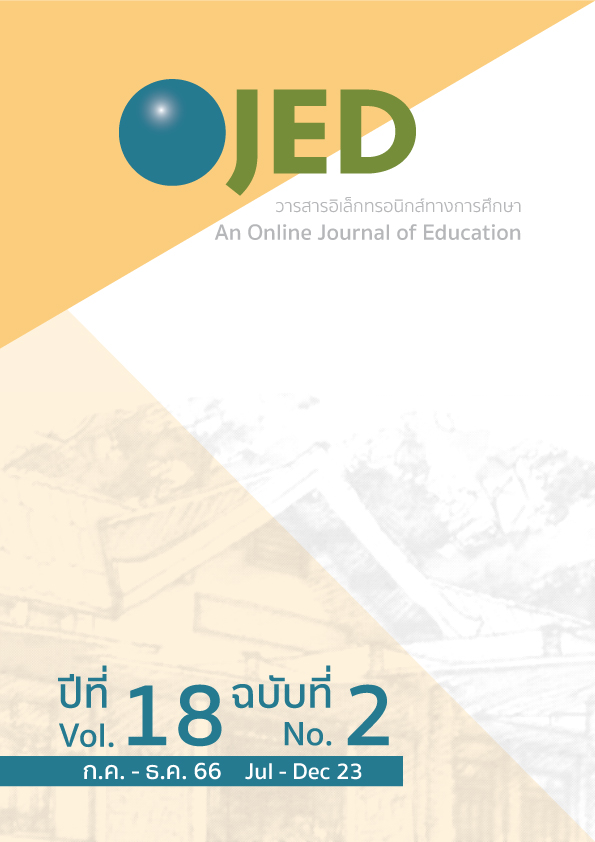EIL Digital Reading Materials for Thai Undergraduate Students
DOI:
https://doi.org/10.14456/ojed.2023.17Keywords:
digital reading, EIL materialsAbstract
This exploratory study aimed to 1) investigate EIL digital reading materials for Thai undergraduate students and 2) explore Thai undergraduate students' perceptions towards EIL digital reading materials. Two hundred and ninety-nine undergraduate students from the aviation business management program participated in this study. The participants, who were aviation business management students, were selected by purposive sampling for the questionnaire. Three participants were selected based on their highest years of experience using digital materials for the semi-structured interview. Results from descriptive statistics of the EIL Digital Reading Materials Questionnaire and thematic analysis of the semi-structured interviews reported that students tended to frequently encounter, engage, and evaluate a variety of EIL digital reading materials. Some sub-reading practices of digital reading were used very frequently, while some were applied on EIL materials at the sometimes level. They almost strongly agreed on their perception toward the use of these EIL digital reading strategies, including encountering, engaging, and evaluating. Implications applied to propose and develop materials for aviation business management instructional practices with an emphasis on reading digital English as an International Language.
References
Buckingham, L. (2015). Shades of cosmopolitanism: EFL teachers' perspectives on English accents and pronunciation teaching in the Gulf. Journal of Multilingual and Multicultural Development, 36(6), 638-653. https://doi.org/10.1080/01434632.2014.994638
Coiro, J. (2011). Predicting Reading Comprehension on the Internet: Contributions of Offline Reading Skills, Online Reading Skills, and Prior Knowledge. Journal of Literacy Research, 43(4), 352-392. https://doi.org/10.1177/1086296X11421979
Coiro, J. (2021). Toward a Multifaceted Heuristic of Digital Reading to Inform Assessment, Research, Practice, and Policy. Reading Research Quarterly, 56(1), 9-31. https://doi.org/https://doi.org/10.1002/rrq.302
Foley, J. (2021). CLT using CEFR and EIL in Southeast Asia and East Asia in the English language classroom. RELC Journal, 53, 003368822199807.
Friedrich, P. (2020). When Englishes go digital. World Englishes, 39(1), 67-78. https://doi.org/https://doi.org/10.1111/weng.12446
Galloway, N. (2017). Global Englishes and Change in English Language Teaching: Attitudes and Impact. New York, NY: Routledge.
IH Admin. (2022). Thailand's Futher Steps into Digitalization. 2023 Trends for Digital Marketing in Thailand. https://www.influencerhouse.co.th/2023-trends-for-digital-marketing-in-thailand/
Jang, E., Seo, Y. S., & Brutt-Griffler, J. (2022). Building Academic Resilience in Literacy: Digital Reading Practices and Motivational and Cognitive Engagement. Reading Research Quarterly. https://doi.org/https://doi.org/10.1002/rrq.486
Kerkhoff, S. N., & Makubuya, T. (2022). Professional Development on Digital Literacy and Transformative Teaching in a Low-Income Country: A Case Study of Rural Kenya. Reading Research Quarterly, 57(1), 287-305. https://doi.org/https://doi.org/10.1002/rrq.392
Lee, J., & Chen Hsieh, J. (2018). University students’ perceptions of English as an International Language (EIL) in Taiwan and South Korea. Journal of Multilingual and Multicultural Development, 39, 1-14. https://doi.org/10.1080/01434632.2018.1438448
Lee, J. S., Chen, J., & Drajati, N. A. (2021). Informal digital learning of English and perceptions of using EIL materials: attitude toward varieties of English as a mediator. Journal of Multilingual and Multicultural Development, 1-16. https://doi.org/10.1080/01434632.2021.2021213
Li, G., & Zhou, W. (2018). Authentic Materials. In The TESOL Encyclopedia of English Language Teaching (pp. 1-13). https://doi.org/https://doi.org/10.1002/9781118784235.eelt0662
Li, J. (2020). Development and validation of Second Language Online Reading Strategies Inventory. Computers & Education, 145, 103733.
Marlina, R. (2017). Teaching English as an International Language: Implementing, Reviewing, and Re-Envisioning World Englishes in Language Education.
McKay, S. (2018). English As an International Language: What It Is and What It Means For Pedagogy. RELC Journal, 49, 003368821773881.
McKay, S. L. (2002). Teaching English As An International Language: Rethinking Goals and Perspectives. New York: Oxford University Press.
Murniati, C., & Sanjaya, R. (2017). Students as Producers: A Case Study of Technology-Based Projects. Celt: A Journal of Culture, English Language Teaching & Literature, 17, 121.
Pavek, C., & Vaughan, M. (2023). Digital Reading Check-ins: Supporting Independent Digital Reading. The Reading Teacher. https://doi.org/10.1002/trtr.2179
Rose, H., McKinley, J., & Galloway, N. (2021). Global Englishes and language teaching: A review of pedagogical research. Language Teaching, 54(2), 157-189. https://www.cambridge.org/core/article/global-englishes-and-language-teaching-a-review-of-pedagogical-research/33B8981A530C97DA2EB0FB4C5AFD3552
Son, J.-B. (2015). Digital literacy. http://drjbson.com/projects/dl/
Son, J.-B., Park, S.-S., & Park, M. (2017). Digital literacy of language learners in two different contexts. JALT CALL Journal, 13, 77-96. https://doi.org/10.29140/jaltcall.v13n2.213
Tarrayo, V. N., Ulla, M. B., & Lekwilai, P. (2021). Perceptions toward Thai English: A study of university English language teachers in Thailand. Critical Inquiry in Language Studies, 18(4), 374-397. https://doi.org/10.1080/15427587.2021.1919113
Tokumoto, M., & Shibata, M. (2011). Asian varieties of English: Attitudes towards pronunciation. World Englishes, 30(3), 392-408.
Tomlinson, B. (2016). Current Issues in the Development of Materials for Learners of English as an International Language (EIL). In W. A. Renandya & H. P. Widodo (Eds.), English Language Teaching Today: Linking Theory and Practice (pp. 53-66). Springer International Publishing. https://doi.org/10.1007/978-3-319-38834-2_5
Tonawanik, P., & Donavanik, N. (2019). Teaching Materials: Adopting and Adapting. Journal of Suvarnabhumi Institute of Technology (Humanities and Social Sciences), 5(2), 635-648.
Turner, K. H., Hicks, T., & Zucker, L. (2020). Connected Reading: A Framework for Understanding How Adolescents Encounter, Evaluate, and Engage With Texts in the Digital Age. Reading Research Quarterly, 55(2), 291-309. https://doi.org/https://doi.org/10.1002/rrq.271
Wongsa, M., & Son, J.-B. (2022). Enhancing Thai secondary school students’ English speaking skills, attitudes and motivation with drama-based activities and Facebook. Innovation in Language Learning and Teaching, 16(1), 41-52. https://doi.org/10.1080/17501229.2020.1853134
Xu, Z. (2017). Developing Meta-cultural Competence in Teaching English as an International Language. In (pp. 703-720). https://doi.org/10.1007/978-981-10-4056-6_31
Downloads
Published
How to Cite
Issue
Section
License
Copyright (c) 2023 An Online Journal of Education

This work is licensed under a Creative Commons Attribution-NonCommercial-NoDerivatives 4.0 International License.




